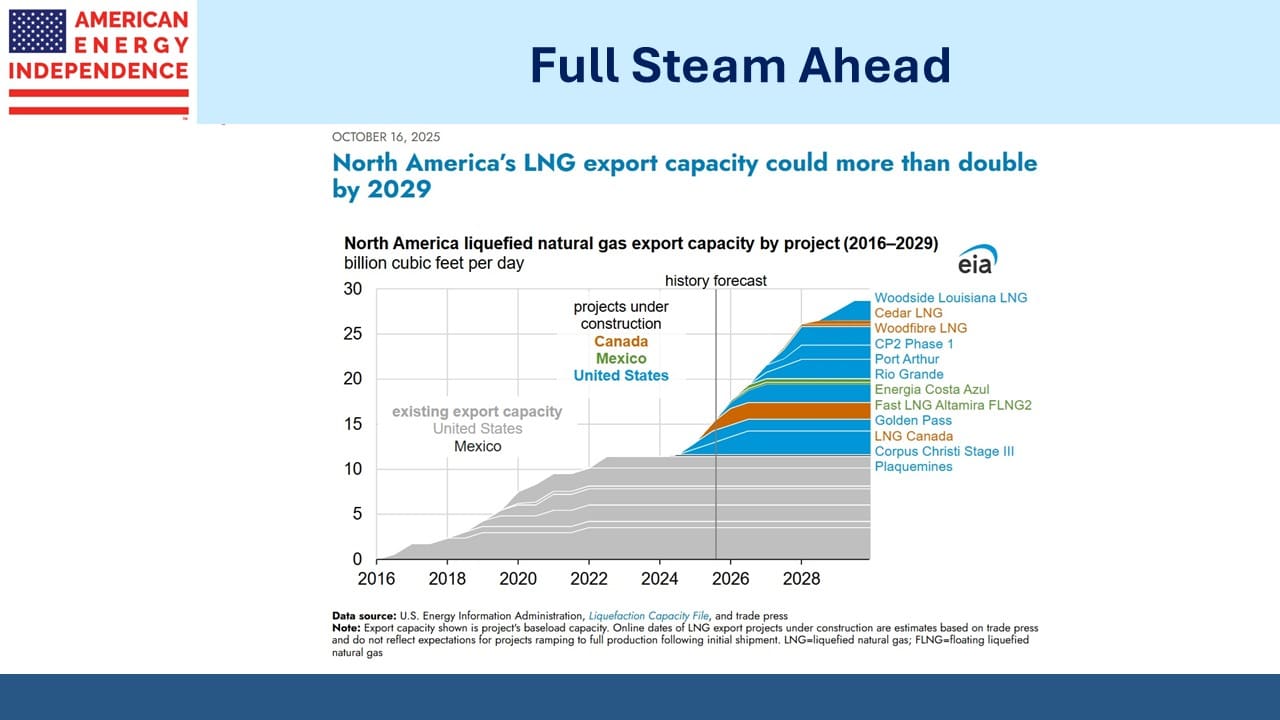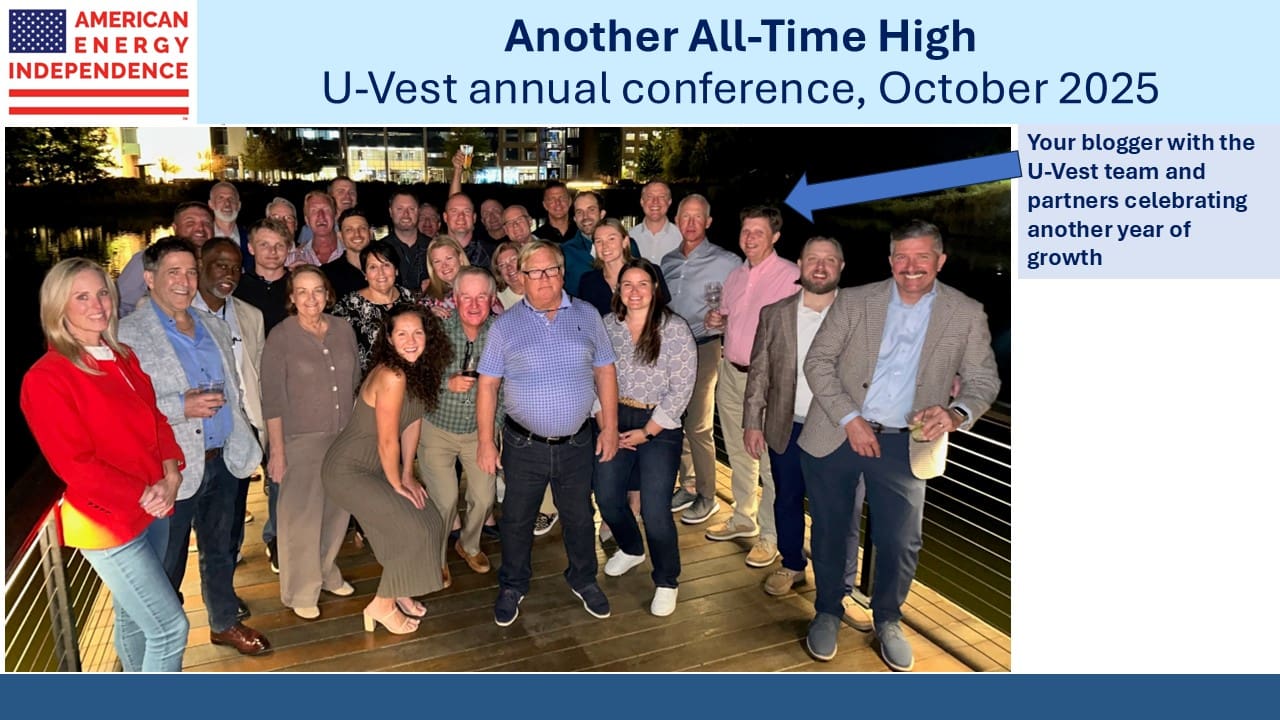Bullish News On Gas

Photo by Martin Adams on Unsplash
Last week, there were two pieces of news that confirmed the bullish long-term outlook for natural gas. On Thursday, the WSJ reported on the Behind The Meter (BTM) arrangements that are becoming common. This is faster than connecting with the grid and, by allocating the costs directly to the data center, it avoids fueling the developing debate about how hyperscalers are driving up household electricity prices.
There were some powerful statistics in the report: data centers are expected to represent 12% of US electricity consumption by 2028, up from only 2% in 2020. Texas expects peak load to be 62% higher by 2030. Natural gas will be the energy source of choice because it’s available, reliable, and cheap.
(Click on image to enlarge)
Also on Thursday, the Energy Information Administration (EIA) updated their forecast for US Liquefied Natural Gas (LNG) export capacity, noting that it could double within four years.
LNG names have been weak. Venture Global remains under a cloud following their loss in arbitration to BP. Witholding expected LNG shipments in 2022 to exploit high spot prices following Russia’s invasion of Ukraine netted a big windfall that’s now at risk to further adverse arbitration decisions. But in our judgment, the market has more than priced in that worst case outcome.
(Click on image to enlarge)
NextDecade announced Final Investment Decision and the close of financing on Train 5 of their Rio Grande LNG terminal, notably without issuing any new equity. They expect to start shipping LNG by 2027, although Train 5 will be operational four years later. This will bring their export capacity to 30 Million Tonnes Per Annum (MTPA).
Market leader Cheniere has a current capacity of 45 MTPA, although this will likely increase by 30 MTPA within five years. Their market cap is $48 billion. Venture Global expects to reach 100 MTPA by 2030 and is worth $22 billion. NextDecade has a market cap of $1.6 billion.
Nonetheless, five-plus years is a long time to wait for full cashflows from NextDecade and the stock, most of which isn’t publicly traded and will likely be subject to periodic swoons in the meantime, as has happened twice this year. But we think ultimately the return will be attractive.
I’ve been traveling through the southeast US this week visiting clients, from DC via Richmond, and on to Fort Mill, Columbia, and Charleston all in South Carolina. Sector performance has been disappointing, but I’ve enjoyed many interesting conversations with long-time investors, and I can report that this group is comfortable with their midstream investments, with some even considering adding to their portfolios.
We’ve also been doing a lot of calls with clients, answering questions they may have, and reinforcing that we believe recent prices represent an interesting opportunity. One investor told me we communicate more than any other investment manager he knows, which was a nice thing to hear. If you’d like to learn more, feel free to reach out. We also held a webinar on Thursday.
(Click on image to enlarge)
I once again joined U-Vest’s Financial’s annual conference, held this year in LPL’s offices in Fort Mill, SC. U-Vest are long-time investors with us, and it’s been wonderful to watch their growth over the years as they add new advisors and offices across Florida, Texas, Georgia, and South Carolina. Mike Davino, Dustin Johnson, and Nick Brinson are building a terrific business.
Many have argued that power generation should rapidly shift to renewables. But solar and wind struggle with intermittency, land use, and grid integration. The current Administration’s hostility to both has added to these challenges, on top of which, costs have been rising. Political risk around the quadrennial presidential cycle will temper enthusiasm for renewables for many years to come.
Consequently, we often get questions on nuclear power and whether that can meet some of the new demand for electricity from data centers, reducing the demand for natural gas. We’d invest in nuclear power if it offered visible recurring cashflows comparable to hydrocarbon infrastructure. Today, it doesn’t, and the costly delays on the Vogtle plant in Tennessee, which was finally completed last year, are enough to dissuade any full-scale projects for now.
There’s lots of R&D into small modular reactors, but the timeline for these initiatives doesn’t match the urgency of hyperscalers in the AI race. However, supportive executive orders and legislation in areas, such as tax credits and streamlined permitting, are improving the odds that nuclear power will eventually play a larger role.
The US Army announced last week that it is planning to add small nuclear power generation reactors on its bases around the world. The US Navy has for decades operated nuclear-powered aircraft carriers and submarines. But this isn’t a model for the civilian sector because they use weapons-grade plutonium, which no country uses for civilian purposes. The Army will rely on non-weapons-grade uranium, and it’ll be encouraging if this plan offers lessons that eventually benefit civilian use.
The prospects for reliable US energy look good. We have two have funds that seek to profit from this environment:
More By This Author:
Gas Isn't HappyWhy Lower Oil Prices Will Boost Natural Gas
Midstream Is Better Under Trump 2.0
Disclosure: The information provided is for informational purposes only and investors should determine for themselves whether a particular service, security or product is suitable for their ...
more





